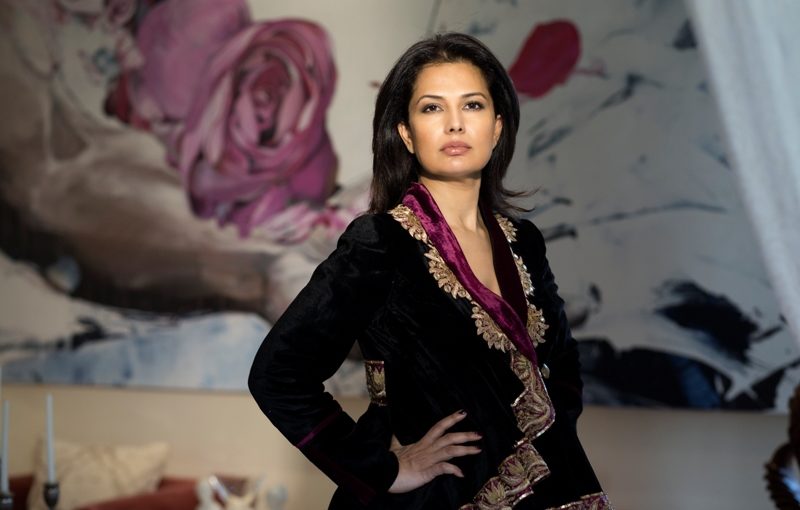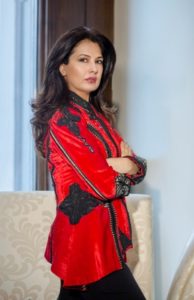

Ritu Beri is the most famous Indian name in the global fashion world. The flourishing Ritu Beri branded stores in many big metros reinforce the appeal of the Ritu brand.
Ritu, the alumnus of the prestigious National Institute of Fashion Technology, in New Delhi launched herself into the global fashion arena after starting with her own label Lakshya in 1990.
The Paris Couture show in 1998 was a big turning point. The global fashion event catapulted Ritu Beri into the top league as fashionistas watched her rise as the star from Asia when Ritu Beri unveiled her first luxe collection in Paris.
In an interview with G. Kalyan Kumar, Editor, Business View, Ritu Beri analyzes the dynamics of the fashion industry in India and abroad in terms of trends, opportunities, challenges and the significance of Indian imprint in fashion.
Ritu is also famous for having designed garments and costumes for celebrities in India and abroad, including Prince Charles, Former US president Bill Clinton, Hollywood actress Andy Mcdowell and many stars in the Indian film industry.
Ritu Beri has written many books. In 2003, Beri published her best-selling book ‘101 Ways To Look Your Best” and in 2006 “Firefly: A Fairy Tale” was released. Ritu is also a consultant for many international brands which include Barby, Swarovski and Volvo.
Excerpts...
The name Ritu Beri brings to mind many images of a fashion icon and an innovative fashion designer. So, how do you summarize the fashion ideology that drives your professional journey?
My designs represent my journey as a human being. Of all the influences I have had in my life, the most important has been India and its cultural heritage. And this is expressed and well interpreted in my clothes. I would say the hallmark of the brand Ritu Beri is intrinsically feminine--romantic with a flamboyant twist. It is more about enchanting a woman`s individuality and her persona. The spirit is feminine, romantic and flamboyant with the silhouettes exuding youthful charm with a definite feel of sensuality and grandeur.
Paris Luxe has been a big milestone in your career and from there how will you sketch your rise to stardom in the fashion industry with trendy creations?
I was offered the prestigious position as the Head of Ready-to-Wear at the French brand, Jean Louis Scherrer, which has been an ultimate break. It was the first time an Asian designer was chosen to head a French house. I was supposed to direct the vision for the brand and had vast opportunities to travel extensively to promote the brand.

For me, being appointed as the Chief Designer of the leading French fashion house, Jean-Louis Scherrer was a real milestone in my career. It was a great honour to be the designer for their prêt-a-porter collections. The foray into an exclusive sorority in the world of fashion has been great at the same time a challenging one too. This appointment also marked the unequivocal entry of India into the top echelons of international fashion.
Never before had a designer of Indian origin, anywhere in the world, been retained by an international fashion label to head a design team.
The term Indian element in fashion is a broader one considering the diverse ethnic strains? How do you explain the Indian touch in your creations?
India has been a constant source of inspiration internationally. India is a land of rich heritage. Indian textiles and embroidery reflect our splendid past and cater very much to the needs and requirements of modern times and I have always tried to incorporate that into my collection.

How far your “Luxury League” has added a new narrative in the fashion domain?
The Luxury League is a not for profit foundation. It is not limited to fashion and involves many facets of the related industries. The whole idea of the luxury league has been to give a new connotation to luxury from an Indian context.
So in India, we have a lot of art, craft and culture. The whole idea is to use that in the form of luxury and respect our bespoke talent and leverage the soft power in branding India globally.
Can you also share your observations on the new trends in contemporary fashion in India and abroad? Also, what role Indian fashion designers are playing in broadening it?
I think, for an Indian designer the greatest blessing is having been born in India and surrounded by vast sources of inspiration, including the colours, the embroideries, and the fabrics, with the resulting possibilities being humungous.
The whole idea for an Indian designer is to use Indian influences magnificently and create trends that the world can follow. So it is not about following any trend or aping something that is already happening internationally.

I believe that we Indian designers are pioneers who got the potential to create trends that the world can follow.
How has the Covid-19 pandemic lull affected the fashion business? Does that help in ideating new trends?
The pandemic did indeed change the face of the fashion industry in a myriad of ways. It has slowed the industry a bit, but not all industries related to fashion have been hit as consumers’ demand shifted to casuals leading to a surge in sales of athleisure wear, which is a big part of the fashion industry.
Online sales have also zoomed. Of course, it does help in tracing new trends and like I said athleisure wear continues to be a big trend as a fall out of the pandemic’s impact on the fashion sector.

What are the emerging avenues where a fashion designer can exhibit the repertoire to grow beyond celebrity dress designing?
Gone were days when a fashion designer would be known only for designing garments and selling them. Now the career options have expanded exponentially. If we are ready to explore there are amazing avenues a fashion enthusiast can discover and do splendid work. It includes fashion photography, fashion influencer, fashion stylist and a more challenging role of fashion art directors. The world is full of new opportunities. I believe a passionate designer can certainly make a big difference irrespective of the niche that he or she has chosen.

What are your brand expansion plans? What is the update on the Baby Beri segment?
Today, more than anything else I am deeply involved in my not-for-profit organization The Luxury League. It was born from my faith in India's rich heritage and culture with the scope to create an increased pool of knowledge and competence that will eventually reinforce the influence of India in the Global Luxury industry.
Baby Beri operates under the Blessed Hearts Foundation. It is another project that is close to my heart. The Blessed Hearts Foundation runs as a charity for children, supporting the underprivileged segments of India. Children bring immense joy to me and I am very proud to be with a foundation whose philosophy envisions a bright future for the children of India. Other than that, there are a few other major projects that I am working on and hopefully, you guys will be aware of them very soon.
You have written a few books with a focus on the fashion sector. Are there any plans to pen more books?
I want to write more and explore the impossibilities in an inspired mode with what fires my passion. To carve a road where there is none, I dream of writing many inspirational books and leaving a legacy that should live beyond me.

Are you for the exclusivity of your brand or open to exploring tie-ups with big corporate houses as Tarun Tahiliani did with Aditya Birla Group?
Well, definitely! I am always open to exploring new possibilities. Here the key is giving my very best whatever I do at a certain point in time. Exploring possibilities for tie-ups and collaborations with brands, I think, is also a great way to enhance visibility and brand outreach.
What is your message to youngsters who want to make fashion design a career in the context of your initiatives like RBFF?
For a successful career, being self-motivated is a parmount requirement with confidence in one’s abilities and the readiness to break the norms. To do so, there must be the courage to stand alone, if required.

I think our younger designers need to be more experimental. There should be no limits or self-imposed barriers and they must be ready to push the envelope. They should believe in themselves and leave no stones unturned to follow their dreams!



